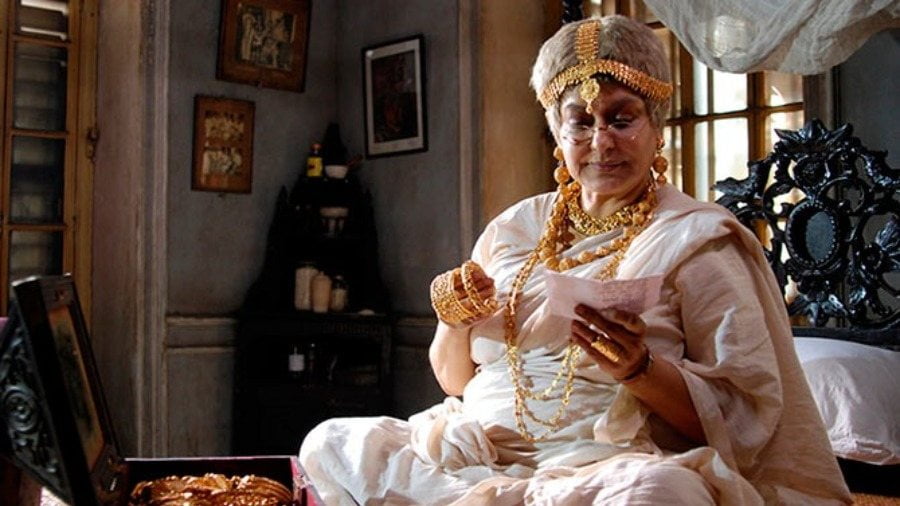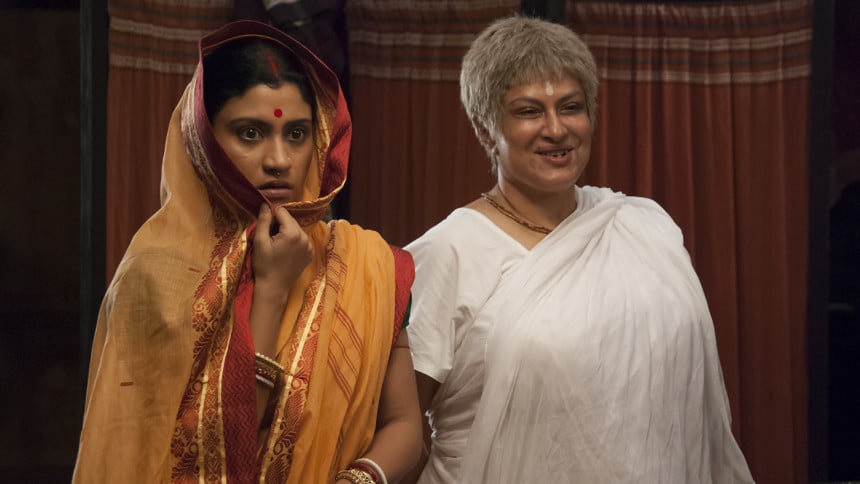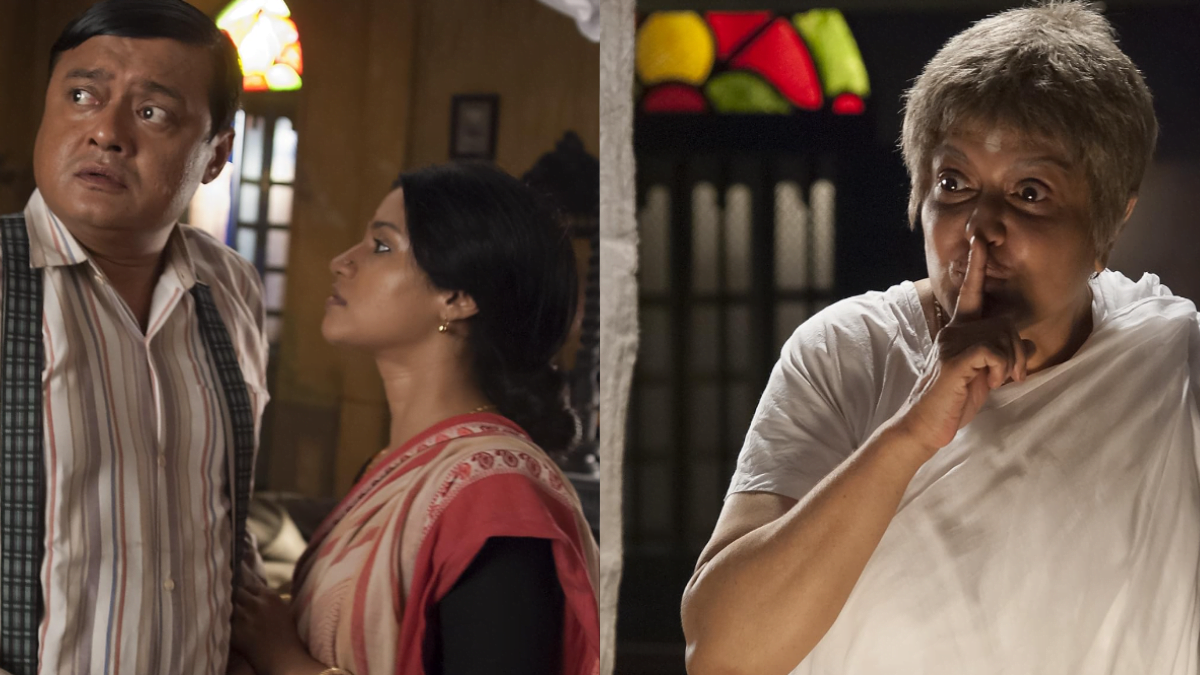Goynar Baksho (The Jewelry Box, 2013) is a horror comedy film that explores the tumultuous relationship three generations of women share with the titular jewellery box, in an upper-caste zamindar (landlord) household in a village. The main protagonist of the film is the widowed, acid-tongued ghost-aunt Rashmoni. As the plot thickens, Rashmoni, who initially dies, re-incarnates as a ghost and saves the allegedly lost jewellery box from the greedy intentions of her brothers and completely alters its course. The film captures the timeframe of the post-partitioned Bengal up to the Bangladesh Liberation War, from 1949 to 1971.
Older aunty figures in mainstream Bengali cinema are largely negative and stereotypical. They are often portrayed as binaries i.e., they are either sacrificial and benevolent do-gooders or bad, evil-scheming women. Aunties largely dwell on the margins of family and social structure. The term ‘aunty,’ is looked upon as a caricature and as a tool of othering. The word conjures up an image of a woman past her prime; bumbling, docile, prone to idle gossip, uninformed, conservative, judgmental, or an assortment of any of these characteristics, mentions Naraharisetty in an article in FII.
Rashmoni, mainly addressed as ‘pishima,’ (paternal aunt) is a mercurial, rebellious, and moody old Brahmin widow who loves her streedhan, the jewellery box. The box contained more than ‘500 bhori,’ of family gold jewellery that Rashmoni inherited from her grandmother as a dowry during her marriage. She leads a secluded life in her ‘chater ghor,’ (attic room) like many widowed aunts would in earlier days. While her room speaks of her social and familial segregation, her cherished jewellery box, which was safely tucked away in a trunk, gives her comfort.
Although the plot begins with women’s reclaiming of rights to property, it unfurls significant discussions on older women’s desire, empowerment, and sexual freedom and raises several questions on age-old traditions pertaining to the practice of Brahmanical Patriarchy such as pativrata (devotion towards the husband) and streedharma (moral duty), social confinement, moral gatekeeping that upper-caste older women are subjected to.
Brahmanical patriarchy, Hindutva politics and the vulnerable old woman
Brahmanical patriarchy, according to Uma Chakraborty’s pathbreaking work Gendering Caste: Through a Feminist Lens (1993), is a unique structure of patriarchal regulations where women play a crucial role in maintaining the caste boundaries. Through the practice of endogamous marriages and upholding the ideology of chastity and pativrata, women retain caste hierarchy and purity.

Older women are especially entrusted with the duty of passing the knowledge of caste values, sexual purity, and ritualistic practices to the younger generation. As soft targets of Hindutva’s divisive ideology, older women take on the roles of Sadhvis and nuns become practitioners of Hindutva politics for the preservation of religious boundaries and upholding of the sanatan Hindu Rashtra (nation) that is firmly rooted in the fundamentalist cultural practices of Hinduism and master-status of Hindu identity, mentions Tanika Sarkar.
When we think about it, there are very few instances where older aunty figures are seen to resist age-old norms of Brahmanical patriarchy and Hindutva politics. Paromita Chakravarty’s essay “The Power of Vulnerability : Age Actvism and the ‘Daadis‘” documents the 2019 CAA protests at Shaheen Bagh where 70 -80-year-old women, who hitherto never stepped out of their homes, used their vulnerable bodies as vanguards of Indian citizenship, secularism and constitutionality. The older women soon became popular internationally as they sat recalcitrant at the protest venue for days, mentions Chakravarty.
Similarly, on August 14th, 2024, many older women took to the streets around midnight to protest against the heinous RG Kar rape-murder incident and joined thousands of women in the Reclaim the Night march, in Kolkata. These are exemplary instances that show how older women display power by utilising their body vulnerability as a powerful weapon of dissent.
Audre Lorde’s erotic power and Rashmoni
Audre Lorde’s essay on Uses of the Erotic theorises erotic love as an insipient power that is hidden from women due to patriarchy. She states that the journey towards the erotic can be mediated through the “beginnings of our sense of self.” This sense of self brings with it the erotic autonomy aiding the recognition of the inherent sense of power, that is critical for self-transformation and subversion. In the Indian cultural landscape expression of erotic autonomy is not common. This happens due to internalised misogyny, cultural norms normalising sexual repression, and overabundant youth-centric discourses on erotic autonomy that exclude older women.

The jewellery box – far from being a master’s tool- becomes Rashmoni’s source of power that triggers the release of her suppressed erotic potential. Had it not been for her tempestuous love for the box, she would not have formed a pact with Somlata and there would be no possibility of opening dialogues on women’s repression.
Three scene sequences depicting Rashmoni’s erotic power
Scene 1: Rashmoni’s untimely child widowhood left her body unfelt, thus in one scene, midway through the film, she repeatedly asks Somlata (grandniece-in-law) “How does it feel?” to have sex. While an overtly coy Somlata finds it hard to articulate how sex feels, indicating that women are linguistically deprived as well, this sensitive scene depicts Rashmoni’s desperate attempt to comprehend sex as sensorial i.e., through the pulse of pleasure, the smell of body, and moments of intimacy.

Scene 2: In a flashback scene, in the process of unmasking her silenced frustration against the systemic patriarchy, Rashmoni recollects how as a young widow she was coerced to curb her ‘basona,’ (burning temptations) of crossing all boundaries of sexual purity in her secret affair with a lowered caste servant Ramkhilaun. Ramkhilaun was murdered by Rashmoni’s family, due to his perversive audacity to sexually malign a Brahmin widow and upset ‘kul morjada,’ (family honour). Shot in sepia mode, this particular subplot echoes the age-old practices of casteism that still delegitimates inter-caste love or marriage in India under the name of ‘love jihad’.
Love jihad is also responsible for constructing a homogenous Hindu master status that comprises upper-class, upper-caste, Brahmin Hindu males. It also prohibits inter-caste and inter-faith marriage, mentions Charu Gupta. Ramkhilaun was a victim of love jihad that led to his murder and, in extension, Rashmoni’s seclusion as a Brahmin widow. Empowered by her erotic, Rashmoni fearlessly critiques these dehumanising practices of widowhood and caste-disciplining of women’s sexuality and subjectivity. She asks questions such as “What sin have, I committed?” or “Don’t women have desires too?“
Scene 3: Rashmoni solicits Somlata’s right to sexual and romantic freedom with her true admirer Rafique, a Muslim poet, “a beautiful young man!” as Rashmoni describes. One night, when secretly visiting Somlata, Rashmoni suggests she “bring him (Rafique) in, shut the doors and…. enjoy[Rashmoni winks].” Rashmoni pushes Somlata to secretly take the plunge into the otherwise forbidden waters of love and pleasure. To convince a timid Somlata, Rashmoni states “A husband is boring! Like everyday clothes. But a stranger is like an expensive saree, you need to wear those sometimes.” Rashmoni’s honest inquisitions hint at the indispensability of youth. She warns Somlata not to underestimate the age-shaming practices by stating “Listen, youth comes just once in a lifetime, remember! Once gone, it never comes back!”
Furthermore, it also underlines the problematic overabundance of youth within the larger discourse of female sexual liberation. Thus, by normalising discussions on love, lust, and female sexual pleasure with men from minority communities in terms of caste (Ramkhilaun) and religion (Rafique) Rashmoni opposes the tyranny of Brahminical patriarchy and Hindutva.

In her illustrious career, from an actress to filmmaker, Aparna Sen has subverted conventions and clichéd renditions of women on screen. At a time when Bengali cinema was plagued with objectification and the male gaze, Sen’s films emerged as a courageous act of rebellion that dismantled the status quo mentions Esha Niyogi De.
Rashmoni is not a stereotypical post-colonial, submissive, upper-caste private aunt. She is an out-and-about byabhicharini, mentions, Aparna Bandhyopadhyay. Rashmoni draws from her inner erotic and openly flouts the suffocating confines of domesticity, casteist traditions of sexual purity, as well as religious sanctimoniousness. Her unique characterisation makes way for “unruly” aunts who become critical for re-evaluating the Indian cinematic discourse.
For Rashmoni, her erotic is a reclamation of her life force and a guiding light that challenges heteropatriarchal practices of Hindutva and casteism that reduce women’s subjectivity, especially that of an older Indian widow. Not only does Rashmoni use this force to breach boundaries for her, but she is also able to use the formidable force to shape the lives of other women around her, mainly, Somlata and later her granddaughter Chaitali. Sen’s bold and unapologetic re-casting of the aunty-figure Rashmoni undoubtedly remains crucial for us to re-imagine ‘ways of seeing,’ older women and imagining their erotic potential. You cannot help but call this shift in the narrative a seismic one!
References
- Chakravarti, Uma. “Conceptualising Brahmanical Patriarchy in Early India: Gender, Caste, Class and State.” Economic and Political Weekly, vol. 28, no. 14, 1993, pp. 579–85. JSTOR, http://www.jstor.org/stable/4399556
- Lorde, Audre. Uses of the Erotic: The Erotic as Power. Trumansburg, 1978.
- Lorde, Audre. “The Master’s Tools Will Never Dismantle the Master’s House.” Sister Outsider: Essays and Speeches, Crossing Press Feminist Series, 1984, pp. 104-107.
- Cultures of Ageing and Ageism in India. CRC Press, 2024.
- The CAA protests and the birth of the Shaheen Bagh movement https://www.thehindu.com/books/the-caa-protests-and-the-birth-of-the-shaheen-bagh-movement/article67968206.ece
- Niyogi De, Esha. “Female-Star-Authorship across South Asia: Genres and Controversy on Pakistani and Indian Screens.” Feminist Media Studies, vol. 22, no. 4, 2020, pp. 848-865. Taylor & Francis, https://doi.org/10.1080/14680777.2020.1815231.
- Naraharisetty, Rohitha. 2018. On Aunty Shaming And Why It Matters To Feminism. December. Accessed July 2021. https://feminisminindia.com/2018/12/18/aunty-shaming/
- Tanika Sarkar. 2001. Hindu Wife, Hindu Nation. New Delhi:: Permanent Black
- Bandhyopadhyay, Aparna. “Byabhichar.” Desire and Defiance: A Study of Bengali Women in Love, 1850-1930, Orient Black Swan, 2016, pp. 150-160
About the author(s)
Madhurima Guha is currently a Doctoral Candidate in Gender Studies at Arizona State University, USA. She earned her BA, MA & MPhil from Jadavpur University. Her Doctoral thesis focuses on non-normative representations of ageing Indian women, their sexualities, desires, and subversive actions in cinema.




